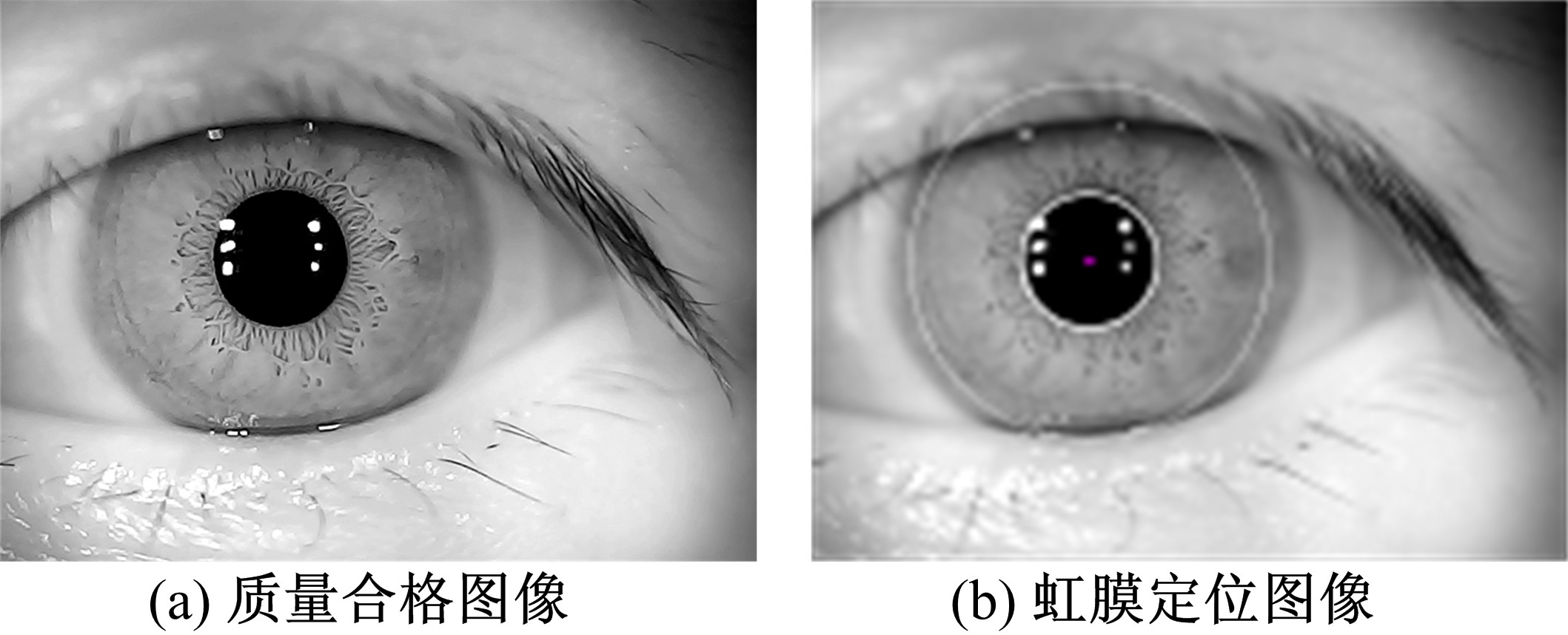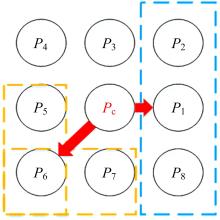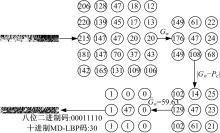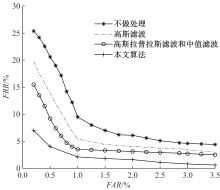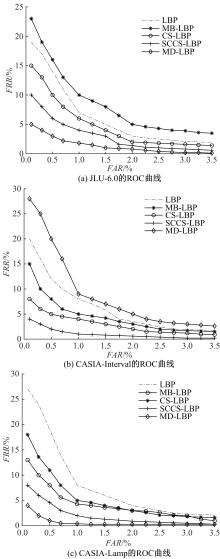Journal of Jilin University(Engineering and Technology Edition) ›› 2021, Vol. 51 ›› Issue (2): 650-658.doi: 10.13229/j.cnki.jdxbgxb20191176
Iris recognition based on multi⁃direction local binary pattern and stable feature
Xiao-dong ZHU1,2( ),Qi-xian ZHANG1,3,Yuan-ning LIU1,2(
),Qi-xian ZHANG1,3,Yuan-ning LIU1,2( ), WU-di1,2,Zu-kang WU1,2,Chao-qun WANG1,3,Xin-long LI1,3
), WU-di1,2,Zu-kang WU1,2,Chao-qun WANG1,3,Xin-long LI1,3
- 1.Key Laboratory of Symbolic Computation and Knowledge Engineering of Ministry of Education,Jilin University,Changchun 130012,China
2.College of Computer Science and Technology,Jilin University,Changchun 130012,China
3.College of Software,Jilin University,Changchun 130012,China
CLC Number:
- TP391.41
| 1 | 王蕰红, 朱勇, 谭铁牛. 基于虹膜识别的身份鉴别[J]. 自动化学报, 2002, 28(1): 1-10. |
| Wang Wen-hong, Zhu Yong, Tan Tie-niu. Identification based on iris recognition[J]. Journal of Automation, 2002, 28(1): 1-10. | |
| 2 | 李星光, 孙哲南, 谭铁牛. 虹膜图像质量评价综述[J]. 中国图象图形学报, 2014, 19(6): 813-824. |
| Li Xing-guang, Sun Zhe-nan, Tan Tie-niu. Overview of iris image quality-assessment[J]. Journal of Image and Graphics, 2014, 19(6): 813-824. | |
| 3 | Daugman J. High confidence visual recognition of persons by a test of statistical independence[J]. IEEE Transactions, 1993, 15(11): 1148-1161. |
| 4 | Wildes R P, Asmuth J C, Green G L, et al. A machine-vision system for iris recognition[J]. Machine Vision & Application, 1996, 9(1): 1-8. |
| 5 | 孙哲南. 虹膜图像特征表达方法研究[D]. 北京: 中国科学院自动化研究所研究生院, 2006. |
| Sun Zhe-nan. A study on iris feature representation[D]. Beijing: Graduate School, Institute of Automation, Chinese Academy of Sciences, 2006. | |
| 6 | Liu J, Sun Z N, Tan T N. Distance metric learning for recognizing low-resolution iris images[J]. Neurocomputing, 2014, 144: 484-492. |
| 7 | Yang D T, Fan P C. Effective scale-invariant feature transform based iris matching technology for identity identification[C]∥In Proceedings of the IEEE International Conference on Consumer Electronics-Taiwan(ICCE-TW), Taichung, 2018: 19-21. |
| 8 | Redman A, Zainal N, Suandi S A. Automated segmentation of iris images acquired in an unconstrained environment using HOG-SVM and GrowCut[J]. Digital Signal Processing, 2017, 64: 60-70. |
| 9 | Han C Y, Kwon S H, Choi H I, et al. Seeded Ising model and the statistical nature of human iris templates[J]. Physical Review E, 2018, 98: 1-7. |
| 10 | Ojala T, Pietikainen M, Maenpaa T. Multi-resolution gray scale and rotation invariant texture classification with local binary patterns[J]. IEEE Transactions on Pattern Analysis and Machine Intelligence, 2002, 24(7): 971-987. |
| 11 | Zhang L, Chu R, Xiang S, et al. Face detection based on multi-block lbp representation[C]∥International Conference on Biometrics. Berlin: Springer, 2007: 11-18. |
| 12 | Heikkila M, Pietikainen M, Schmid C. Description of interest regions with local binary patterns[J]. Pattern Recognition, 2009, 42(3): 425-436. |
| 13 | 李欢利, 郭立红, 李小明, 等. 基于统计特征中心对称局部二值模式的虹膜识别[J]. 光学精密工程, 2013, 21(8): 2129-2136. |
| Li Huan-li, Guo Li-hong, Li Xiao-ming, et al. Iris recognition based on SCCS-LBP[J]. Optics and Precision Engineering, 2013, 21(8): 2129-2136. | |
| 14 | 刘帅. 基于粒子群优化改进的虹膜特征提取与识别算法的研究[D]. 长春: 吉林大学软件学院, 2019. |
| Liu Shuai. Research on iris feature extraction and recognition algorithm based on improved particle swarm optimization[D]. Changchun: College of Software, Jilin University, 2019. | |
| 15 | Daugman J G. How iris recognition works[J]. IEEE Transactions on Gircuits and System for Video Technology, 2004, 14(1): 21-30. |
| 16 | Liu S, Liu Y N, Zhu X D, et al. Iris double recognition based on modified evolutionary neural network[J].Journal of Electronic Imaging, 2017, 26(6): 1-11. |
| 17 | Zhang Q X, Zhu X D, Liu Y N, et al. Iris recognition based on adaptive optimization log-gabor filter and rbf neural network[C]∥14th Chinese Conference on Biometric Recognition. Cham: Springer, 2019: 312-320. |
| 18 | 毛星云, 冷雪飞. OpenCV3编程入门[M]. 1版, 北京: 电子工业出版社, 2017. |
| 19 | de Souza J M, Gonzaga A. Human iris feature extraction under pupil size variation using local texture descriptors[J]. Multimedia Tools and Applications, 2019, 78(15): 20557-20584. |
| 20 | 吉林大学生物识别与信息安全技术实验室. 虹膜库[EB/OL]. [2019-10-25]. |
| 21 | 中国科学院自动化研究所. 共享虹膜库[EB/OL]. [2019-10-25]. . |
| 22 | 刘元宁, 刘帅, 朱晓冬, 等. 基于决策粒子群优化与稳定纹理的虹膜二次识别[J]. 吉林大学学报: 工学版, 2019, 49(4): 1329-1338. |
| Liu Yuan-ning, Liu Shuai, Zhu Xiao-dong, et al. Iris secondary recognition based on decision particle swarm optimization and stable texture[J]. Journal of Jilin University (Engineering and Technology Edition), 2019, 49(4): 1329-1338. | |
| 23 | Liu S, Liu Y N, Zhu X D, et al. Unsteady state lightweight iris certification based on multi-algorithm parallel integration[J]. Algorithms, 2019, 12(9): 1-24. |
| [1] | LIU Yuan-ning, LIU Shuai, ZHU Xiao-dong, CHEN Yi-hao, ZHENG Shao-ge, SHEN Chun-zhuang. LOG operator and adaptive optimization Gabor filtering for iris recognition [J]. Journal of Jilin University(Engineering and Technology Edition), 2018, 48(5): 1606-1613. |
| [2] | HU Yun-feng, GU Wan-li, LIANG Yu, DU Le, YU Shu-you, CHEN Hong. Start-stop control of hybrid vehicle based on nonlinear method [J]. 吉林大学学报(工学版), 2017, 47(4): 1207-1216. |
| [3] | GU Wan-li, ZHANG Sen, HU Yun-feng, CHEN Hong. Nonlinear controller design of brushed DC motor [J]. 吉林大学学报(工学版), 2017, 47(3): 900-907. |
| [4] | MA Bei, ZHANG Hai-lin, ZHANG Zhao-wei, ZHONG Ming. Imperfect channel state information based D2D power allocation algorithm [J]. 吉林大学学报(工学版), 2016, 46(4): 1320-1324. |
| [5] | WANG Yu, SHEN Xuan-jing, CHEN Hai-peng, TAN Ying. Video-based face texture representation and recognition with fusion features from multi-view [J]. 吉林大学学报(工学版), 2015, 45(6): 1954-1960. |
| [6] | QIU Chun-ling, TAO Qiang, FAN Run-long, WANG Pei-zhi. Zircon image matching method based on description of SIFT feature by LBP [J]. 吉林大学学报(工学版), 2014, 44(6): 1793-1798. |
| [7] | LI Gen,LI Wen-hui. Face occlusion recognition based on MEBML [J]. 吉林大学学报(工学版), 2014, 44(5): 1410-1416. |
| [8] | LI Yi-bing,CHANG Guo-bin,YE Fang. Exponential entropy-based spectrum sensing algorithm in cognitive radio [J]. 吉林大学学报(工学版), 2014, 44(5): 1506-1511. |
| [9] | WANG You-wei, LIU Yuan-ning, ZHU Xiao-dong. Novel robust watermarking algorithm for regional attacks of digital images [J]. 吉林大学学报(工学版), 2014, 44(4): 1151-1158. |
| [10] | LIU Fu, HOU Tao, LIU Yun, ZHANG Xiao. A variable trade-off parameter support vector domain description [J]. 吉林大学学报(工学版), 2014, 44(2): 440-445. |
| [11] | LI Huan-li, GUO LI-hong, WANG Xin-zui, LI Xiao-ming, DONG Yue-fang, FANG Yan-chao. Iris recognition based on weighted Gabor filter [J]. 吉林大学学报(工学版), 2014, 44(01): 196-202. |
| [12] | ZHANG Yuan-yuan, LI Jing, JIANG Shu-ming, YANG Zi-jiang, ZHANG Jiang-zhou. Local features of gait energy image through the method of texture analysis [J]. 吉林大学学报(工学版), 2013, 43(增刊1): 193-198. |
| [13] | CHEN Chen, DANG Jing-min, HUANG Jian-qiang, WANG Yi-ding. DFB laser temperature control system with high stability and strong robustness [J]. 吉林大学学报(工学版), 2013, 43(04): 1004-1010. |
| [14] | LIU Shu-cheng, PAN Xin, WEI Wei, YAN Qing-dong, LAI Yu-yang. Complexity-based robustness analysis of turbulence model in torque converter flow field simulation [J]. 吉林大学学报(工学版), 2013, 43(03): 613-618. |
| [15] | DAI Jin-bo, XIAO Xiao, ZHAO Hong-wei. Human face recognition based on low resolution local binary pattern [J]. 吉林大学学报(工学版), 2013, 43(02): 435-438. |
|
||

